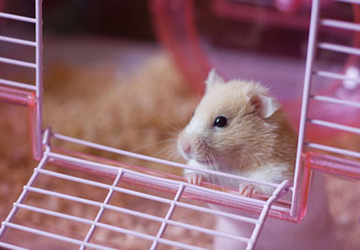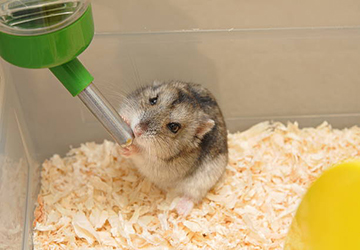What Every Hamster Owner Needs in Their Starter Kit
With their curious eyes and cheeky personalities, HAmster cats make charming pets that can brighten up any home. However, these tiny creatures have specific needs that, when met, ensure they lead healthy, active, and happy lives. Being well-prepared is crucial to bringing one of these furry friends home. Here's a guide on what every hamster owner needs in their starter kit, from setting up a hamster habitat to choosing the right hamster wheel.
Essential Items for Hamster Care
Before bringing your new pet home, it's vital to have a checklist of essential items for hamster care:
● Cage or Enclosure: This will be your hamster's primary living space. Ensure it's spacious, well-ventilated, and secure to prevent potential escapes.
● Water Bottle: Hamsters need a constant supply of fresh water. A hanging water bottle is a clean way to provide this.
● Food Dish: A shallow dish serves hamster food pellets perfectly.
● Hamster Food: Purchase high-quality hamster pellets that cater to their nutritional needs.

Setting Up a Hamster Habitat
Setting up a hamster habitat is more than just placing a cage on a table. It's about creating a comfortable and stimulating environment:
● Location: Place the cage away from direct sunlight, drafts, and loud noises. A stable temperature is essential for your hamster's well-being.
● Toys: Hamsters are active and curious. Providing toys like tunnels, bridges, and hideouts can keep them engaged.
● Chew Toys: Hamsters have continuously growing teeth. Offering wooden chew toys or cardboard tubes can help keep their teeth in check.
The Best Bedding for Hamsters
Hamsters love to burrow, and the best Bedding for hamsters facilitates this natural behavior:
Paper-based Bedding is absorbent and dust-free, making it ideal for hamsters. Ensure the paper hasn't been treated with any chemicals.
● Aspen Shavings: Another suitable option, aspen doesn't have the harmful phenols found in pine or cedar shavings.
● Depth: Regardless of the bedding type, ensure a depth of 1-2 inches for your hamster to burrow and nest.
Choosing the Right Hamster Wheel
Physical activity is crucial for a hamster, and choosing the right hamster wheel plays a pivotal role:
● Size: The wheel should be large enough so that your hamster doesn't arch its back while running. Typically, a wheel between 6.5 to 12 inches in diameter is suitable, depending on your hamster's size.
● Solid Surface: Opt for wheels with a solid running surface, as barred wheels can cause injuries.
● Stability: Ensure the wheel is stable and won't tip over.
Diversifying the Hamster's Diet
While commercial hamster food forms the core of your pet's diet, it's beneficial to offer a bit of variety:
● Fresh Vegetables: Small pieces of carrots, broccoli, or cucumbers can be a treat. Remember to introduce them slowly to prevent digestive upsets.
● Proteins: Occasionally, you can provide tiny amounts of cooked plain chicken or unsalted nuts as a protein boost.
● Treats: While available at pet stores, ensure that treats are given sparingly to avoid overfeeding.
● Caution: Avoid citrus fruits, onions, chocolate, and any sugary or processed human foods, as these can be harmful.
Understanding Hamster Social Needs
Hamsters are unique when it comes to their social behaviors:
● Syrian Hamsters: These are solitary animals and prefer living alone. Housing two together can result in fights.
● Dwarf Hamsters: These might appreciate the company of their kind but constantly monitor for signs of aggression.
● Playtime: Interaction with their human caretakers is vital. Spend time daily allowing your hamster to roam in a secure playpen or a safe room under supervision.
Grooming and Cleaning
Though hamsters are relatively low-maintenance, they do require some grooming:
● Bathing: Unlike cats and dogs, hamsters don't need baths. Water can strip essential oils from their fur. If your hamster gets into something messy, use a damp cloth to clean them.
● Dust Baths: Some hamsters, especially dwarf varieties, enjoy dust baths. Offering a bowl of chinchilla dust can help them keep their fur clean and provide entertainment.
● Nail Trimming: Keep an eye on your hamster's nails. If they get too long, gently trim them with a small nail clipper.
● Cage Cleaning: Regular cleaning of the habitat is vital. Remove old food daily, spot clean areas with waste, and thoroughly clean, replacing the Bedding weekly or bi-weekly.
The beauty of owning a hamster lies in the small details. Observing their quirks, understanding their needs, and ensuring their well-being can lead to a rewarding experience for both the owner and the pet. As with all animals, the more attention to detail and care you provide, the more joy and companionship you'll receive.

Health Monitoring for Hamsters
Just like any pet, hamsters can face health challenges. Regular monitoring is critical:
● Weight Checks: Sudden weight loss can be a sign of illness. Consider weighing your hamster at regular intervals to track any changes.
● Coat and Skin: A shiny coat is a sign of a healthy hamster. Dull fur, bald patches, or skin irritations may indicate health issues or parasites.
● Eyes and Nose: These should be clear and free from discharge. Watery or crusty eyes or a runny nose might indicate a cold or respiratory infection.
● Behavioral Changes: If your usually active hamster becomes lethargic or rejects food, it's a sign to consult a vet.
Safe Handling of Hamsters
Hamsters are gentle creatures, but they can be startled easily:
● Slow Movements: Always move slowly and predictably to avoid scaring your hamster.
● Hand-Feeding: Offering treats from your hand can help build trust between you and your pet.
● Safe Holding: Scoop up the hamster with both hands when picking it up, ensuring it feels secure.
● Avoiding Bites: Hamsters use their teeth to explore. If you're concerned about biting, handle them with gloves until you become more accustomed to each other.
Enhancing Your Hamster's Quality of Life
To ensure your hamster leads a fulfilled life:
● Exercise Outside the Cage: Allow your hamster time outside its cage in a safe, enclosed space. Exercise balls, specifically designed for hamsters, can be a fun way for them to explore while staying protected.
● Mental Stimulation: Rotate toys and introduce new challenges to keep your hamster mentally engaged. Puzzle toys or mazes made from cardboard can be exciting for them.
● Quiet Time: Remember, hamsters are nocturnal. Ensure they have a calm environment during the day to rest without disturbances.
● Regular Vet Visits: Regular check-ups with a vet experienced in small animals can help catch and address health issues early.
In summary, hamsters, though small, have a range of needs that, when met, can ensure they lead a vibrant, healthy life. The dedication of a thoughtful owner can make all the difference in the lives of these delightful creatures. Remember, the more love and care you give, the more joy you'll receive.




